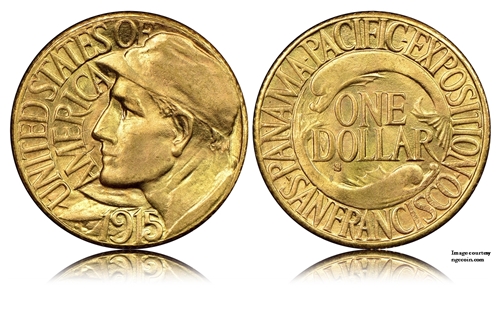
The 1915 Pan-Pacific Gold Dollar
The second coin called for in the January 16th 1915 act authorizing coins to commemorate the Exposition and the opening of the Panama Canal was the gold dollar.
Although the act called for the coins to be ready for sale by the start of the exposition on February 20th, this was clearly going to be impossible.
The gold dollar design was to be done by Charles Keck. In total he submitted four designs before one was finally approved by Treasury Secretary McAdoo in early March.
Being such a small coin the design needed to be simple yet bold and Keck did a good job in this regard. The obverse is dominated by the left facing bust of a canal labor worker wearing a cap. The field in front of his face is completely filled with UNITED STATES OF AMERICA in two lines. The space below his jaw and left of his neck bears the date 1915. The first impression you get when you see this coin is that it is ALL design. Keck left just barely enough field to keep everything from running into each other.
The reverse continues the packed in look with the inscription PANAMA PACIFIC EXPOSITION SAN FRANCISCO encircling two dolphins. The dolphins were to symbolize the joining of the Atlantic and Pacific Oceans by the Panama Canal. Between the dolphins is the denomination ONE DOLLAR in two lines. The S mintmark is below the DO of DOLLAR. Once again there is just enough field area to keep everything barely separated.
All 25,000 coins authorized were struck but possibly they had some problems with the striking because some were struck in May, June, and finally July. They were offered for sale initially at a $2.25 price. This apparently met a lot of resistance because the price was quickly reduced to $2 each. This helped some but it was realized before the end of the exposition that they were not going to sell all of the coins and ten thousand of them were sent back for melting on November 1st 1915, a month before the show closed.